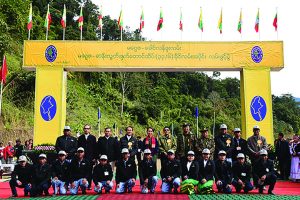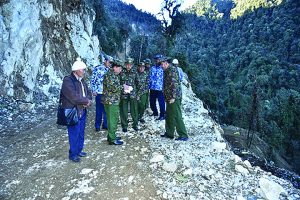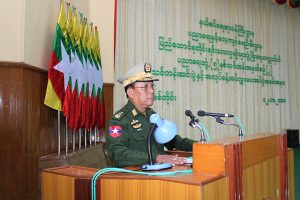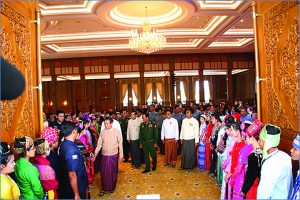“While successive governments have endeavored for development along the country’s borders, they have still lagged behind due to various reasons. Thus, the Ministry of Border Affairs was established to ensure there was no lapse in the border and ethnic development of the various regions of Myanmar.”
U Ye Naing, Permanent Secretary
Interviewer: Naing Lin Kyi
Photos by Aung Zaw Myo (Border Affairs)
The Ministry of Border Affairs was created to overcome the several shortcomings regarding border control and improving the standard of living of the border towns. In an interview with media representatives, the officials gave us a glimpse of the many accomplishments of the ministry during the 3rd year of the current administration.
Ministry of Border Affairs Permanent Secretary, U Ye Naing
Q: What are some activities and policies the Ministry is working towards?
A: We focus on areas that is difficult to travel, doesn’t have much population and places that are far to reach with different dialects and languages spoken. The Ministry is currently working towards a functioning democratic federal system through the Myanmar Sustainable Development Program, a feat that the previous governments have failed to do so.

While successive governments have endeavored for development along the country’s borders, they have still lagged behind due to various reasons. Thus, the Ministry of Border Affairs was established to ensure there was no lapse in the border and ethnic development of the various regions of Myanmar.
The policies include (a) stability of border areas (b) development of border areas (c) development of socioeconomic life of people living in border areas and (d) development of human-resources of ethnic people residing in border areas.
These include projects such as: building infrastructures and roads/bridges, improving access to safe and clean water, increase access and quality of healthcare available in the area, provide electricity through power line, solar power and engines. The ministry also brings food and other resources such as affordable low-cost housing to IDPs, and armed groups who are willing to stop fighting.
There are several areas we give close attention to when giving out aid such as the 7 States and 2 Region that have borders and 6 self-administered zones totaling of 167 Townships (30,000 villages) with the potential to cover up to 37 percent of the people.

The ministry has completed up to 608 miles of roads, 191 bridges (including 11 big bridges), 183 box culvert, 29 basic education schools, 4 health centers, 30 drinkable water stations, 99 miles of clean water distribution pipes, 2 transformers, 1735 solar lights, 31 miles of electric cables and 8 hydro stations.
Q: Any other huge accomplishments that the ministry has achieved within the past year?
A: Well, there is one for instance in Kachin State, Putao Khaunglanphu area which took 12 days of trekking to reach. Food often doesn’t reach there by ground transport and the ministry has to support food supply with airlifts. After the road was constructed, the State Counsellor Daw Aung San Suu Kyi, who is Chairperson of Central Committee to Implement the Development of Border Areas and Ethnic Nationals, visited there for the opening at the Maggwayza-Sanlotchat mountain top which was the hardest part of the road to travel. The Tatmadaw Senior General also greatly supported the construction with his visit and also supplied Tatmadaw helicopters and equipment.

The road, when completed, will stretch up to 64 miles and we are more than halfway done. It will also contribute to the overall development in the area by boosting tourism in the area as the area has quite the biodiversity and scenes with ice-covered mountain caps. Now that there is easier access, it will hopefully attract more people. We expect to complete 16 miles this year.
Q: Can you tell us a little bit about the road linking Northern and Southern Shan State?
A: There are plans to build from Yatsawk, Kyauk Gu to Hsipaw, Nam Lan. The road is roughly 89 miles long. The construction in the North is taken care of by Department of Public Works while the southern part is built by the Ministry of Border Affairs. This road will greatly cut the time taken for supplies to reach the north.
Q: What about for access to clean water initiative in Kayah?
A: The work in Kayah State was for access to water in Panpat area. It was quite the challenge; we had to dig up to 100 feet underground, pump the water with pipes that are connected through mountains over mountains so that we can provide for 17 villages in a 50 square mile. We also had to build 38 water tanks along with over 13 miles of water pipes laid across.
Q: What are some of your collaborations with international organizations?
A: We collaborated with the Nippon foundation of Japan in Shan State, Bridge Asia Japan in Rakhine to build over 200 schools, 100 repairs along with cyclone shelters in Rakhine.
Q: What are some challenges the ministry has faced along the way?
A: The ministry has received several complaints on the quality of its work. This has mostly been due to the restricted funding and the nature of the job itself. We would like to give the best possible service to the citizens as possible. Often, our dreams are limited to the funding available. However, we hope to be able to improve and build on existing structures once they have been commercialized (eg. Being able to collect tolls). Another restriction was where the job often is. The terrain is hard to reach and often, the weather isn’t ideal. For instance, it rained starting the whole of February when we were constructing the Kaung Lan Pu road so we were only able to work when it didn’t rain for three months in November, December and January.
Q: Any additional comments you’d like to make?
A: The Ministry is working towards development of border areas, socioeconomic life of people living in border areas and human resources of ethnic people residing in border areas. This is part of brining the whole country up into development. This is a plan that has been planned for generations and we still have not succeed completely. However, we are working towards this goal and really appreciate the support from the public on developing all areas and aspects of the country.
U Thein Htay Oo
Director General, Education and Training Department
Q: Can you explain to us the purpose of setting up the Education and Training Department?
A: The Education and Training Department was founded on 1999, June 30th with two main aims: to educate ethnic people residing in border areas through basic and tertiary education along with vocational training and improve human resources of people in the area. There is the Education and Training Department headquarters, University for Development of National Races in Sagaing, two degree colleges for ethnic youth in Yangon and Sagaing, one central training school, 45 border youth development training centers, 9 mechanical schools and 5- women’s vocational training schools.
Q: Can you elaborate more on the 3 areas of capacity building the ministry is working on?
A: So the three areas are regarding basic education, tertiary education and vocational training. There is a total of 45 border youth development training centers who houses free of charge youth from 5th to 10th grade. There is a total of 29470 students that have attended the school so far with 2367 students accepted into colleges. There was a total of 6679 people in attendance for the youth training school in the 2018-2019 school year. There is one University for Development of National Races, two degree colleges for ethnic youth and one central training school for tertiary education.
Q: What are the benefits of the degree colleges for ethnic youth?
A: We give out B.Ed for qualified youth and they also have a chance to further pursue their masters and PhD. Just last year, the degree colleges have 165 B.Ed graduates, 11 masters. The graduates then move on to work as teachers in the Ministry of Education with assignments to the relevant areas/towns. During the 2018-2019 school year, there were 1629 students in the Bachelors program and 25 pupils in the 2 year masters program. Fifteen of the relevant ministries along with the development councils also hire out of the schools to work in their respective ministries as government officials. We have had a total of 3870 graduates. Students can also attend the masters and doctorate programs. We a total of 601 masters and above graduates from the school so far and last year, 2325 students were enrolled in the school. To this date, we have trained over 13740 students total with 570 alone in the last year through 8 different training courses.
Q: Can you explain to us about the vocational schools?
A: Vocational schools equip the students with real life skills they can use to generate income later on. We have a total of 9 schools for ethnic youth that teaches classes such as welding workshops, phone repairs classes, bike repair classes, and the basics of wiring a house. Last year, we had a total of 711 students. There are also 45 vocational schools for ethnic women that teaches them to sew, use modern sewing machines or use traditional methods for cloth. The schools also conducted hospitality training courses such as how to mix drinks, greet guests and cook, teaching up to 6010 students in the 45 schools during the 2018-2019 school year.
Q: What about job prospects?
A: The Ministry of Education have employed more than 10000 students as high school teachers after they have graduated from the degree school. They are employed at 15 relevant ministries along with State/Regional development councils as government employees. The vocational training centers have also produced 1378 graduates that are now working in car repair shops, bike service centers, welding shops and electricity companies. For women, up to 21955 graduates were surveyed to have found jobs and are now working at private garment factories. Certificates are also given along with help in finding employment in Yangon. For instance, 29 garment factories have signed graduates from these schools to work for them. The Pathein and Pakokku training centers for hospitality and tourism also opened December 2017 and has trained up to 387 students.
The Education and Training Department has taken recommendations from the Ministry to keep working on capacity building in the ethnic youth community to help develop the resources of the state and benefit the region as a whole.
(Translated by Myat Thu)



